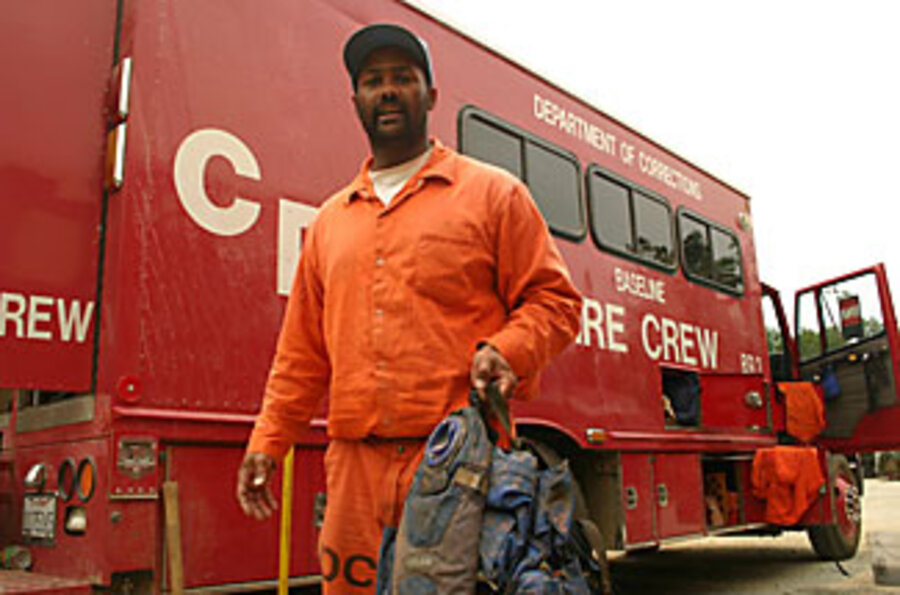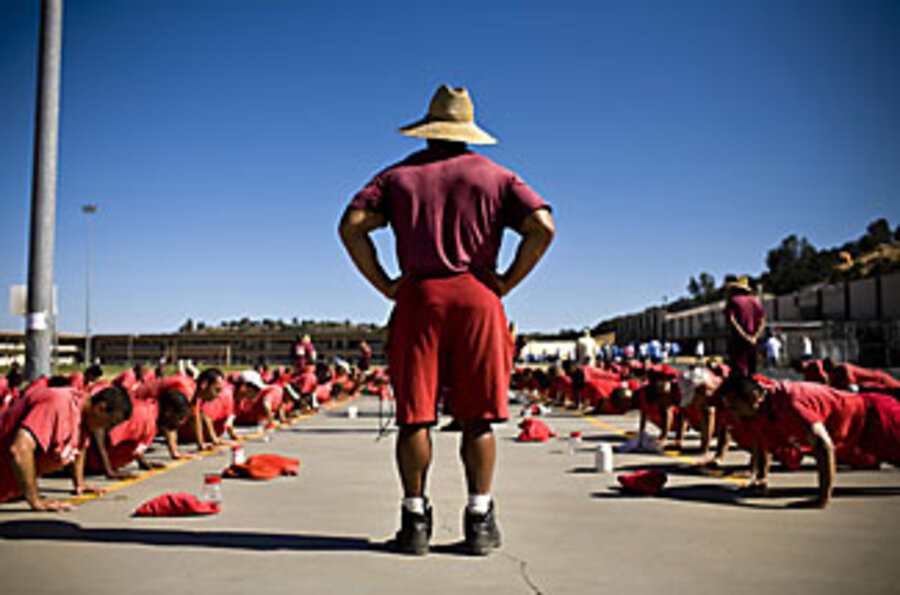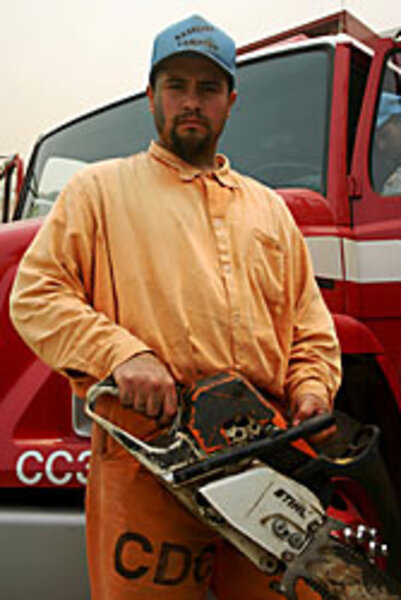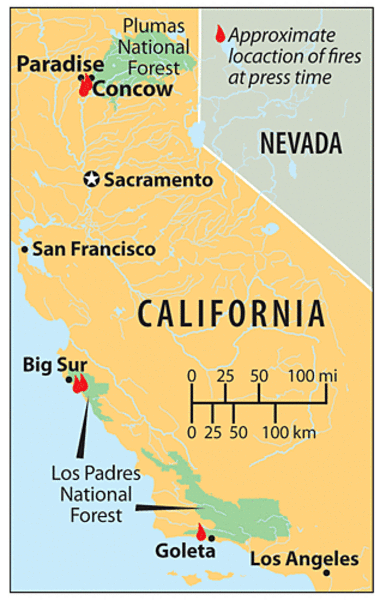Battling California fires, inmates find a chance at better role
Loading...
| Big Sur, Calif.
The fire whirl came spinning up the steep slopes of Big Sur like a dust devil of flame. It headed for the new guy on the fire crew, Billy Gray, who threw on his shroud and bowed his head just in time. The whirl washed over him, then exploded into a grass fire.
"I turned and yelled, 'Spot fire!' I thank God I didn't get burned," says Mr. Gray, recounting his recent baptism as a prison inmate-turned-firefighter. More than 1 in 10 firefighters here at the Basin Complex – California's biggest blaze – are trained state prisoners.
Despite the danger and 24-hour shifts involving 3,000-foot climbs with 40-pound packs, Gray pushes on. "Plenty of times I've wanted to quit," he says. "It teaches you to persevere."
With 2,500 trained prisoners currently fighting fires, California's inmate firefighting program has proved invaluable as the state struggles to throw enough manpower at this year's lightning-strike siege. The 60-year-old program even seems to be weathering the budget crunch in Sacramento.
For the prisoners, firefighting fosters new growth in their character,
like Sequoia seeds loosed by wildfire.
"We can be going from one fire to another driving down the highway, and people pull up just saying thank you," says firefighter Anthony Candido, who is dressed in an orange corrections jumpsuit. "Even though I have to wear these colors, I still feel important."
Residents are trickling back into Big Sur, an artsy community in central California tucked against dramatic seaside slopes. While firefighters have made progress containing 41 percent of the 90,114 acre inferno, the fire's presence in the mountains above can still be felt along coastal Highway 1. The seasonal Pacific fog mingles with smoke, and ash comes down in gentle flurries. "We heart firefighters" signs line the road and windows.
If anyone is worried about having convicts working the fire lines, it's not Craig Allan, manager of a newly reopened pub here. "I'm glad to have anybody come here and help," he says. "What's worse: Having someone break into the building or having it go up in flames?"
The program has had few escapes or incidents of misbehavior, say officials. "I don't worry too much. When the bell rings, they are firemen and they act like firemen," says Mike Parry, a crew technical specialist with the state agency CAL FIRE. "The inmates, at least in our camp, really never let me down on a fire."
The state just doesn't have the money to hire more crews to do this kind of frontline spadework, says Mr Parry. Inmates are paid $1 an hour for fighting fires and get time shaved off their sentences. Non-inmate labor, he notes, goes for $10 to $12 an hour, not counting overtime.
The voluntary program sets some requirements: no arsonists, sex offenders, or high-level prisoners. Graduates must pass tests of physical stamina and firefighting basics.
The program saves California taxpayers more than $80 million annually on average, according to the California Department of Corrections and Rehabilitation (CDCR).
The use of prison labor in the US has expanded with the growing ranks of inmates and a general loosening of the rules governing the practice, says Noah Zatz, a law professor at University of California, Los Angeles.
Critics of prison labor, he says, worry that it can take jobs from regular workers while not extending worker protections to the inmates. Few states pay inmates minimum wage, and only some – including California – provide workers comp. The legal justification for such exemptions, he says, grows weaker if the purpose is less rehabilitation than cost-savings.
The pay differential does grate on the inmate firefighters, who hear the regular crews talk of buying boats with their pay checks.
"But I can't be mad at anybody but myself," says inmate firefighter Floyd Smith. When a disability prevented his wife from working, Mr. Smith says that rather than scale back on extras like a platinum cable package, he dealt drugs.
Firefighting has helped him value other things, namely the support of his wife and others in the community. "To be able to come here and do something productive and help society, it gives you a feeling of self-fulfillment and accomplishment," says Smith, who hopes to counsel troubled teens upon release.
Others like Mr. Candido plan to parlay their firefighting skills into a career.
CDCR says roughly 3 to 5 percent of released inmate firefighters get jobs with CAL FIRE, the Forest Service, or private crews. CDCR doesn't know how many firefighter inmates wind up reoffending.
The last time Candido was paroled, he knew in his heart he'd be back.
"Society I thought was totally against me and didn't give me the opportunity or chance to make money legitimately," says Candido. In 33 days, he was picked up again on armed robbery charges.
Now the firefighting program has opened a career path and taught him life skills. The first: Follow the rules. As a rookie, he cranked up his chain saw without protective gear. An experienced sawyer noticed the mistake and slammed on the emergency brake just as the chain started to slice into Candido's leg.
"He took the saw away from me and gave me a lecture," says Candido. "I'm very grateful for that guy. He cared enough."
Now a veteran of 20 big fires, Candido says the experience showed him he could work hard. That's an understatement. His job places him at the front of a line of men who must clear a firebreak on terrain too tough for dozers.
Often the team follows the hot line to create a firebreak and hose access. That means a wall of flames – rising 20 feet high at times – rages just a yard or two away from the crew. Sweat pours "like Niagara Falls" under the suits, says Candido. Working farther from the fire, though, can mean shivering on a wind-swept ridge.
Such temperature extremes sent one inmate at the Basin Complex to a hospital. Many firefighters are also battling rashes from the poison oak that blankets Big Sur.
But there are moments of serenity, too: Candido saw his first ocean sunset here.









